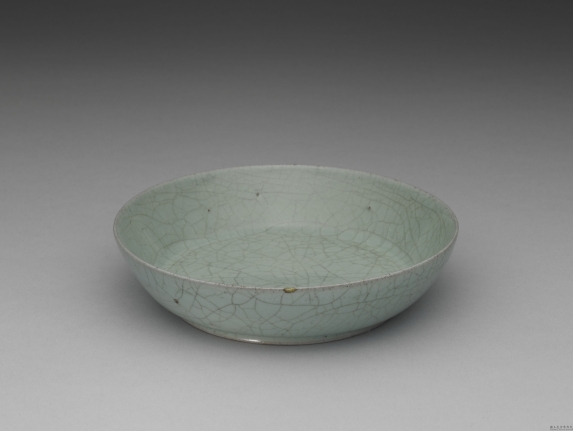Dish with celadon glaze, Ru ware, Northern Song dynasty, late 11th- early 12th century
- Image Number: K1B008284N000000000PAB
- Dynasty: Northern Song dynasty
- Category: Ceramics
- Function: Stationery and stationery
- Material: Mineral/ceramic/porcelain
- Description:
It has a wide mouth, shallow wall, flat bottom, and the foot is slightly rolled out. The body is thin and covered with sky blue glaze, and the thin glaze shows light pink luster. There are ice cracks at the glazed area on the inner wall. There are three branch burn marks left at the bottom circumference, from which the earth colored tire can be seen. The face is engraved with Emperor Qianlong’s “Chanting the Plate of the Official Kiln”: “Only the light is regarded as Dingzhou, and the secret vessels of the official kilns are used as treasures. It is rare to see them alone because they are far away from the world, but most of them still go to the market to beg”, an imperial poem. At the end of the poem, the chronicle of “Emperor Qianlong’s reign in the mid afternoon of the Qing Dynasty and the Emperor of the Moon” (the 51st year of the reign of Emperor Qianlong: 1786) was signed, with two seals of “Bide” and “Langrun”. Because the Book of Rites says, “A gentleman can compare virtue with jade”. In the Book of Zhou, “Guangcai Langrun” was also used to describe the natural luster of stone. Emperor Qianlong praised jade articles, often with the words “Jade Virtue is Constant and Warm” (“Zhou Jade Red Sabre”), and “Morality is a Gentleman” (“Chanting

![图片[2]-Dish with celadon glaze, Ru ware, Northern Song dynasty, late 11th- early 12th century-China Archive](https://chinaarchive.net/Northern Song dynasty/Ceramics/K1B008284N000000000PAB-30261.jpg)
![图片[3]-Dish with celadon glaze, Ru ware, Northern Song dynasty, late 11th- early 12th century-China Archive](https://chinaarchive.net/Northern Song dynasty/Ceramics/K1B008284N000000000PAB-30262.jpg)
Pictures & Images [HD] download
© Copyright
The copyright of the article belongs to the author, please keep the original link for reprinting.
THE END





